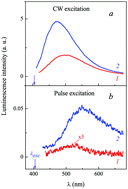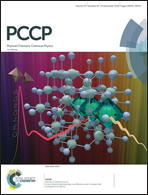Effect of dark states on the fluorescence of carbon nanodots
Abstract
The nonlinear fluorescence properties of colloidal carbon dot solutions in glycerol were investigated at T = 298 K and 77 K. It was first found that the fluorescence intensity depended sublinearly on optical excitation intensity even at moderate excitation levels. With increasing excitation, the fluorescence signal shows a trend toward saturation, the latter being most pronounced at liquid nitrogen temperature. The relation between the fluorescence intensity and the excitation density was shown to be well approximated by the hyperbola equation. The behavior of the fluorescence intensity was theoretically described by a 3-level model that involves the singlet fluorescent state S1 and optically “dark” triplet state T1 of a carbon dot. The triplet states are almost inactive optically and manifest themselves in a very weak phosphorescence of the carbon dots that is several orders weaker than the fluorescence of the dots. The lifetimes of the triplet state were measured to be 0.75 ms at room temperature and 0.25 s at T = 77 K. Within the model used, the intersystem crossing (S1 → T1) lifetime in the carbon dots was estimated to be τIST ∼ 10−5 s at T = 77 K and τIST ∼ 10−6 s at T = 298 K.

- This article is part of the themed collection: 2018 PCCP HOT Articles


 Please wait while we load your content...
Please wait while we load your content...